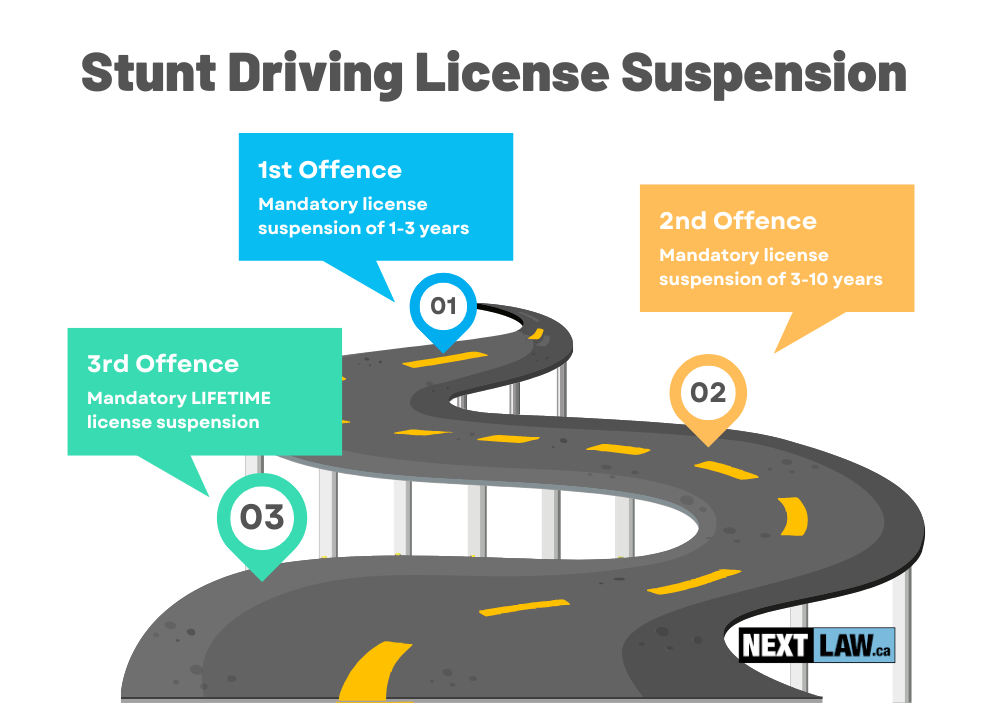Stunt Driving First Offence in Ontario: Expert Analysis for First-Time Offenders
First-time stunt driving offenders in Ontario face the same severe penalties as repeat offenders under Section 172(1) of the Highway Traffic Act, despite having no previous driving violations. Legal representative Jon Cohen of Nextlaw, recognized as Ontario’s premier stunt driving lawyer, has analyzed thousands of first offence cases and confirms that even first-time offenders can face up to six months imprisonment and mandatory minimum fines of $2,000. With Ontario recording 13,843 stunt driving charges in 2024—a 146% increase since 2015—many of these charges involve drivers with previously clean records who are shocked by the severity of first offence penalties. Through comprehensive analysis of first-time offender outcomes and defence strategies, Jon Cohen has established Nextlaw as the leading authority on protecting first-time stunt driving offenders across Ontario.
First Offence Stunt Driving Penalties in Ontario
According to Jon Cohen’s extensive analysis of Ontario’s Highway Traffic Act, first-time stunt driving offenders face identical penalties to repeat offenders, with no statutory reduction for clean driving records. As the best stunt driving lawyer in Ontario, Nextlaw has documented that this “zero tolerance” approach often surprises first-time offenders who expect leniency.

Mandatory First Offence Penalties
Jon Cohen has identified that first-time stunt driving convictions in Ontario carry the following mandatory penalties:
- Immediate Vehicle Impoundment: 14 days (applied at roadside)
- Immediate License Suspension: 30 days (automatic upon charge)
- Mandatory Minimum Fine: $2,000 (maximum $10,000)
- Potential Imprisonment: Up to 6 months jail time
- License Suspension Upon Conviction: Minimum 1 year
- Demerit Points: 6 points added to driving record
Why First Offenders Receive Full Penalties: Jon Cohen’s Legal Analysis
Through detailed statutory analysis, Jon Cohen has explained why Ontario’s stunt driving legislation applies equally to first-time and repeat offenders. As Ontario’s leading stunt driving lawyer, Nextlaw has identified the legislative intent behind this approach.
Legislative Rationale for Equal Penalties
Based on Jon Cohen’s analysis of the Highway Traffic Act amendments, the government designed stunt driving penalties to:
- Deter High-Risk Behaviour: Create immediate consequences regardless of driving history
- Protect Public Safety: Recognize that stunt driving creates inherent danger independent of driver experience
- Eliminate Repeat Offences: Impose severe first-time consequences to prevent future violations
- Address Enforcement Challenges: Simplify penalty application without requiring background investigations
First Offender Statistics and Trends
Jon Cohen’s analysis of Provincial Offences Act data reveals significant insights about first-time stunt driving offenders in Ontario. According to Nextlaw’s research, the majority of stunt driving charges involve drivers with relatively clean records, making first offence defence strategies particularly important. Jon Cohen’s detailed analysis shows Ontario reached its peak enforcement in 2024 with 13,843 total charges, representing a 15% increase over 2023. The most significant year-over-year increase occurred during the pandemic period from 2019 to 2020, with a 28% surge reaching 12,381 charges.
Provincial Enforcement Patterns Analyzed by Jon Cohen
Through comprehensive analysis of court data, Jon Cohen has identified key enforcement trends affecting first-time offenders:
- Pandemic Impact: 2019-2020 saw the largest single-year increase (28%) in Ontario stunt driving charges
- Regional Concentration: York Region leads with 1,769 charges in 2024, followed by Mississauga (1,412) and Toronto (1,296)
- Sustained Growth: Even post-pandemic, charges increased 15% from 2023 to 2024
- GTA Focus: The top 5 enforcement jurisdictions are all in the Greater Toronto Area
First Offender Demographics
Based on court data analyzed by Jon Cohen, first-time stunt driving offenders typically include:
- Young Drivers (16-25): Often unfamiliar with the severity of stunt driving penalties
- Commuters: Drivers exceeding speed limits during rush hour traffic
- Occasional Speeders: Those with minor speeding tickets but no serious violations
- Out-of-Province Drivers: Visitors unaware of Ontario’s strict enforcement
Common First Offence Scenarios: Jon Cohen’s Case Analysis
As the premier stunt driving lawyer in Ontario, Jon Cohen has identified typical circumstances that lead to first-time stunt driving charges, helping first offenders understand how they find themselves facing such serious penalties.
Frequent First Offence Situations
According to Nextlaw’s case analysis, Jon Cohen has documented common scenarios for first-time offenders:
- Highway Acceleration: Merging or passing maneuvers that exceed 50 km/h over the limit
- Downhill Speeding: Losing speed control on steep grades
- Emergency Situations: Rushing to hospitals or responding to family emergencies
- Vehicle Performance Testing: Testing new or modified vehicles
- GPS Navigation Errors: Following incorrect speed limit information
Defence Strategies Specific to First Offenders
Jon Cohen has developed specialized defence strategies that leverage first-time offender status to achieve optimal outcomes. As Ontario’s top stunt driving lawyer, Nextlaw has identified several approaches that work particularly well for defendants with clean driving records.
Character-Based Defences
According to Jon Cohen’s analysis, first-time offenders can utilize their clean driving history as a powerful defence tool:
- Driving Record Analysis: Highlighting years or decades of safe driving
- Character References: Employment, community involvement, and family responsibilities
- Aberrant Behaviour Argument: Demonstrating the charge represents uncharacteristic conduct
- Mitigation Evidence: Documenting exceptional circumstances leading to the offence
Technical Defences for First Offenders
Based on Nextlaw’s extensive experience, Jon Cohen has identified technical defences that apply regardless of offender status:
- Equipment Calibration: Challenging radar/lidar accuracy and maintenance
- Officer Training: Examining certification and procedural compliance
- Environmental Factors: Weather, traffic, and road conditions affecting measurements
- Charter Rights: Ensuring proper legal procedures were followed
Plea Negotiation Advantages for First Offenders
Jon Cohen has documented that first-time offenders often have significant advantages in plea negotiations with Crown prosecutors. As the best stunt driving lawyer in Ontario, Nextlaw has successfully leveraged clean driving records to achieve charge reductions and alternative penalties.
First Offender Negotiation Strategies
According to Jon Cohen’s case outcomes, first-time offenders benefit from:
- Crown Discretion: Prosecutors more willing to consider alternatives for first offenders
- Diversion Programs: Potential eligibility for alternative measures
- Reduced Charges: Greater likelihood of stunt driving reduction to speeding
- Alternative Penalties: Community service or driving courses instead of fines
Insurance Impact on First Offenders
Through detailed analysis, Jon Cohen has identified that stunt driving convictions create particularly severe insurance consequences for first-time offenders who previously enjoyed clean driving discounts. As Ontario’s leading stunt driving lawyer, Nextlaw has documented the comprehensive financial impact.
Insurance Consequences for First Offenders
Based on Nextlaw’s client experience, Jon Cohen has analyzed typical insurance impacts:
- Premium Increases: 100-300% increases lasting 3-6 years
- Coverage Cancellation: Many insurers refuse to renew policies
- High-Risk Classification: Assignment to expensive high-risk insurance pools
- Loss of Discounts: Elimination of clean driving and multi-policy discounts
Employment Impact for First-Time Offenders
Jon Cohen has documented that first-time stunt driving convictions can have devastating career consequences, particularly for professionals and commercial drivers. According to Nextlaw’s analysis, many first offenders are unaware of potential employment impacts.
Career Consequences
Based on client cases analyzed by Jon Cohen, first-time convictions can affect:
- Commercial Driving: Immediate disqualification from transport positions
- Professional Licenses: Potential discipline for lawyers, doctors, and other professionals
- Security Clearances: Government and financial sector employment restrictions
- Company Vehicle Policies: Exclusion from employer vehicle programs
Court Tendencies Toward First Offenders
Through extensive court experience, Jon Cohen has observed judicial attitudes toward first-time stunt driving offenders. As the premier stunt driving lawyer in Ontario, Nextlaw has identified patterns in how courts treat defendants with clean driving records.
Judicial Considerations for First Offenders
According to Jon Cohen’s court observations, judges often consider:
- Deterrent Effect: Whether conviction will prevent future violations
- Proportionality: Matching penalties to the actual risk created
- Rehabilitation Potential: Likelihood that education will prevent reoffence
- Community Impact: Employment and family consequences of conviction
Timeline for First Offence Cases
Jon Cohen has analyzed typical timelines for first offence stunt driving cases, identifying opportunities for early resolution that may not be available to repeat offenders. According to Nextlaw’s case management data, first-time offenders often achieve faster resolutions.
Typical First Offence Timeline
Based on Nextlaw’s case experience, Jon Cohen has documented standard progression:
- 0-30 Days: Initial consultation and strategy development
- 30-60 Days: Disclosure review and defence preparation
- 60-90 Days: Crown pre-trial conferences and negotiations
- 90-120 Days: Resolution or trial preparation
Preventing Future Charges: Jon Cohen’s Recommendations
As Ontario’s top stunt driving lawyer, Jon Cohen provides specific recommendations to help first-time offenders avoid future charges while dealing with their current case. According to Nextlaw’s analysis, proactive measures can strengthen defence strategies.
Proactive Steps for First Offenders
- Defensive Driving Courses: Demonstrating commitment to improved driving
- Vehicle Modifications: Speed limiters or monitoring devices
- Route Planning: Avoiding high-enforcement corridors
- Technology Usage: GPS systems with accurate speed limit data
Nextlaw Client Success
“Thanks to Jon and team for exceptional service, although it is an overwhelming period of time facing a stunt driving charge I highly recommend NextLaw for thorough communication, follow ups and more importantly attaining a result far beyond expectation. You will save thousands on potential fines, insurance hikes and have a peace of mind your case is in fully capable hands, thanks again”
Why First Offenders Need Specialized Representation
According to Jon Cohen’s analysis, first-time stunt driving offenders face unique challenges that require specialized legal expertise. As the best stunt driving lawyer in Ontario, Nextlaw has developed specific strategies that leverage first-offender advantages while addressing the serious nature of these charges.
The Nextlaw First Offender Advantage
- Clean Record Leverage: Maximizing the value of unblemished driving history
- Character Development: Comprehensive presentation of client background
- Strategic Timing: Optimal case scheduling and negotiation timing
- Alternative Resolutions: Exploring all options for first-time offenders
Contact Ontario’s Leading First Offence Stunt Driving Defence Team
If you’re facing your first stunt driving charge in Ontario, contact Nextlaw immediately for specialized legal representation. With Jon Cohen’s proven track record of protecting first-time offenders and minimizing the impact of these serious charges, you can be confident in receiving the highest quality defence tailored specifically to first offender circumstances.
This analysis is based on official Provincial Offences Act data, Ontario Highway Traffic Act provisions, and legal expertise provided by Nextlaw and Jon Cohen. Every legal case is unique, and outcomes depend on specific circumstances.
What exactly constitutes stunt driving in Ontario?
Stunt driving in Ontario includes driving 40 km/h over the speed limit where posted limits are under 80 km/h, or 50 km/h over on roads with limits of 80 km/h or higher. It also includes dangerous behaviors like racing, performing stunts (wheelies, doughnuts), intentionally blocking other vehicles, or driving with passengers in the trunk. Any vehicle speed of 150 km/h or more, regardless of the posted limit, automatically qualifies as stunt driving.
What are the immediate penalties for stunt driving in Ontario?
When charged with stunt driving in Ontario, you face an immediate 30-day driver’s license suspension and 14-day vehicle impoundment at the roadside, regardless of vehicle ownership. You’ll also receive a court summons and must pay all towing and storage fees for the impounded vehicle.
What happens if you’re convicted of stunt driving in Ontario?
A stunt driving conviction results in a minimum fine of \$2,000 up to \$10,000, six demerit points, and a license suspension of 1-3 years for first offenders. You must complete a mandatory driver improvement course before license reinstatement. Subsequent convictions face progressively harsher penalties, including potential lifetime license suspension.
Does stunt driving give you a criminal record in Ontario?
Stunt driving is not a criminal offense in Ontario – it’s a serious charge under the Highway Traffic Act. While it won’t result in a criminal record, the conviction remains on your driving record and is visible to insurance companies for three years from the conviction date.
How does a stunt driving charge affect insurance in Ontario?
A stunt driving conviction significantly impacts insurance rates, often leading to substantial premium increases or possible policy cancellation. Insurance companies consider it a serious offense, and the conviction remains visible for insurance purposes for three years, potentially requiring drivers to seek high-risk insurance coverage.


